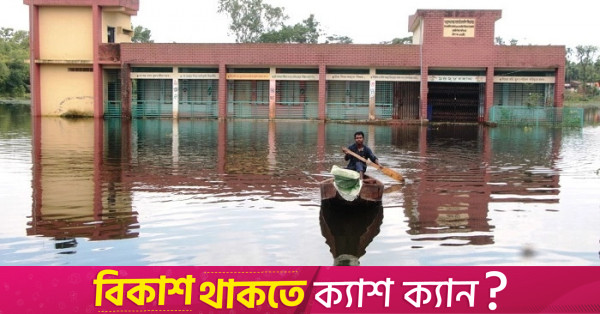Education bears the brunt of flooding in Sylhet


Academic activities came to a halt at about 500 educational institutions of mostly primary and secondary levels across Sylhet as the third wave of flooding hit the district this year.
Moreover, the unprecedented flooding caused damage to roads, agriculture, and fisheries in the northeastern district of Bangladesh but the education sector has been hardest hit.
Some school buildings have been submerged while others are being used as shelter centres. As a result, classes have been suspended since the Eid holidays.
To bridge the learning gap, secondary schools nationwide started classes on June 26 instead of July 2. However, many secondary schools in Sylhet have not resumed classes post-Eid. The same situation exists in primary schools.
Although primary schools were supposed to reopen on July 3 after the Eid holidays, this has not been possible due to the flooding in Sylhet.
According to sources, 398 primary schools and 78 secondary schools in the district are currently closed due to flooding. Several colleges have also faced the situation.
The District Primary Education Office said that out of 1,477 primary schools in the district, 398 are closed.
In Sylhet Sadar upazila, 37 schools are closed; 2 in Bishwanath, 55 in Balaganj, 55; 32 in Fenchuganj, 27 in Golapganj, 54 in Beanibazar, 23 in Zakiganj, 4 in Kanaighat, 3 in Jaintapur, 3; 2 in Gowainghat, 65 in Companiganj, 22 in Dakshin Surma, and 72 in Osmaninagar are closed.
District Primary Education Officer Sakhawat Ershed told UNB that 167 of these 398 primary schools are being used as shelters and the rest are submerged.
District Education Officer Abu Sayeed Md. Abdul Wadud said, “Due to the flooding, 78 secondary schools in the district have halted classes. The most affected areas are Osmaninagar, Balaganj, and Fenchuganj upazilas where the floodwaters in the Kushiyara basin have not receded.”
He also said that the longtime suspension of classes is causing severe harm to students’ education. Once the water recedes, efforts will be made to compensate for the lost time through additional classes.
The first wave of flooding in Sylhet occurred on 29 May, submerging six border upazilas due to heavy rainfall and upstream mountain runoff. The water level began to recede after 8 June.
However, flooding resumed on 16 June, affecting all 13 upazilas in the district, including Sylhet city, and impacting over 10 lakh people. The second wave of floodwater began to recede on 25 June.
Heavy rainfall and runoff caused another round of flooding starting 1 July




